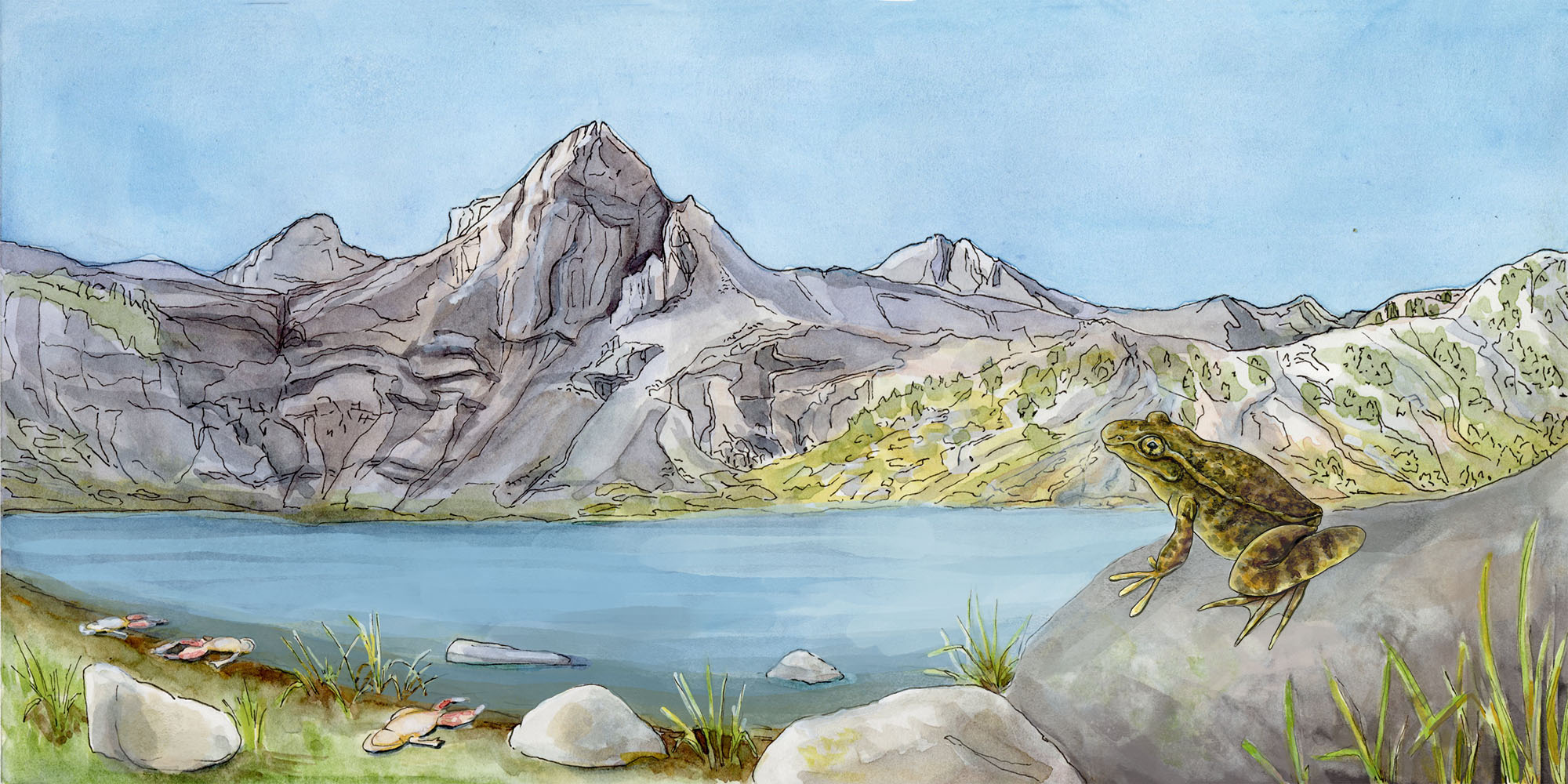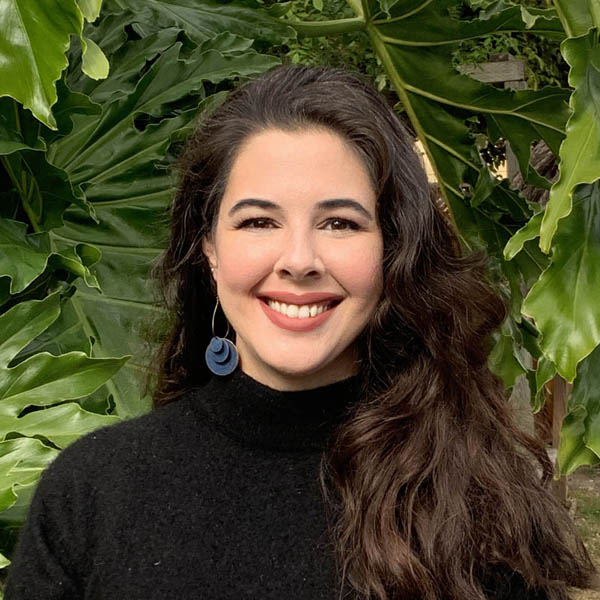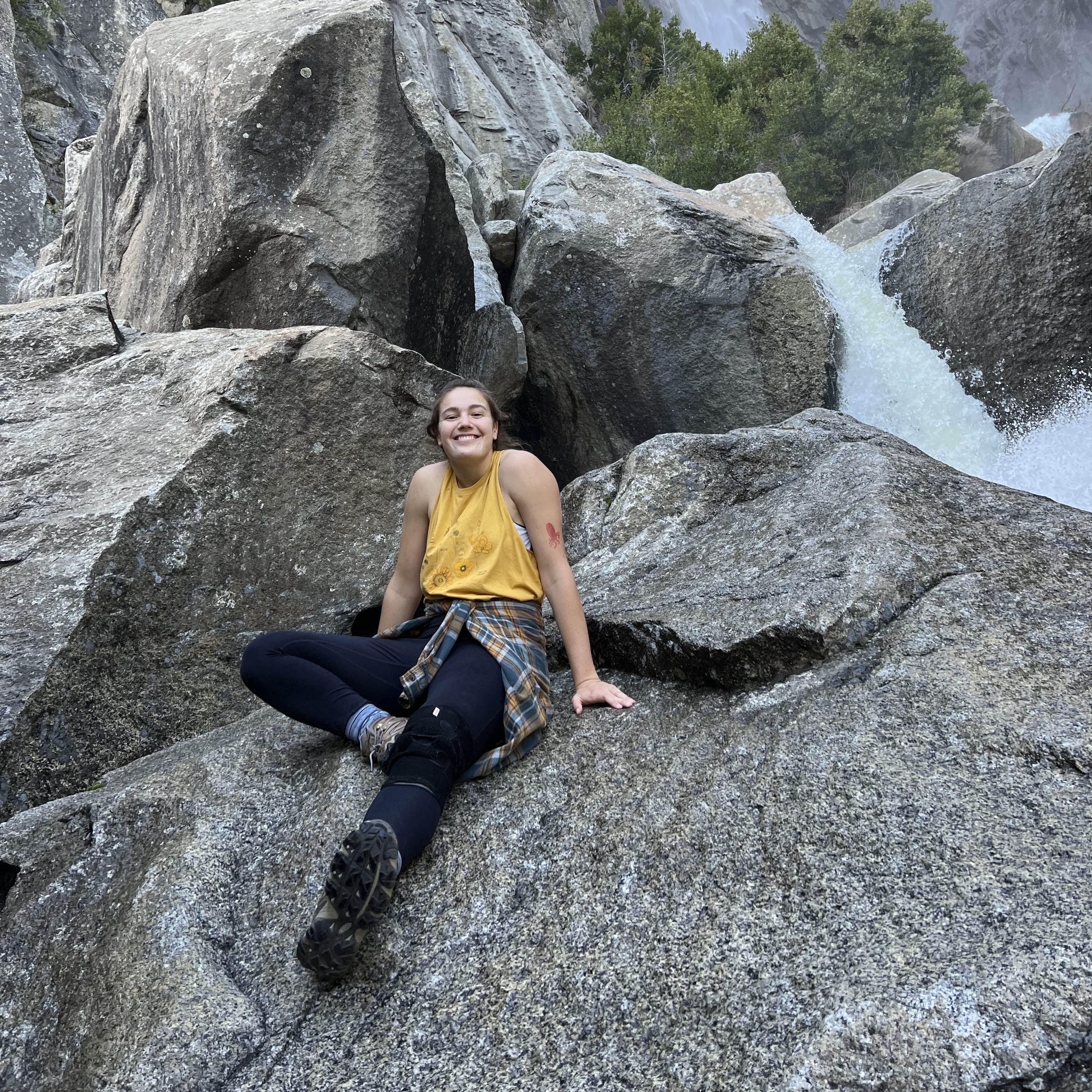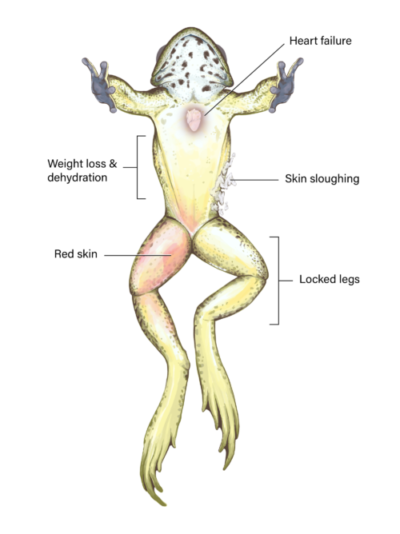Fungus Fighters
The mountain yellow-legged frog has emerged victorious in this tale of resurrection and recovery from chytrid, Emily Moskal reports. Illustrations by Nina Grauley and Maria Klos.

Illustration: Nina Grauley
When Vance Vredenburg started working in the remote Sierra Nevadas in 1995, there were so many mountain yellow-legged frogs that it sounded like rain when he’d walk past a lake and they’d jump into the water. However, in just over a decade, the lakes would fall silent.
In 2008, Vredenburg, an ecologist at San Francisco State University, found himself crying on the edge of Sixty Lake Basin in Kings Canyon National Park after his surveys revealed the deaths of tens of thousands of frogs. His studies revealed that only about two dozen frogs remained in one of the most pristine, rugged terrains of California.
“I saw all these frogs that I’d helped create habitat for floating and dying in front of me,” said Vredenburg. “And there was nothing I could do. It was the worst time of my life.”
Since 1980, more than 100 species of amphibians have gone extinct, many at the hands of a quickly spreading fungal pathogen called chytrid. For the devastation that Vredenburg documented was only temporary; now, mountain yellow-legged frogs and a few other species have made an incredible comeback. Scientists are looking into what helped the frogs gain resistance to the fungal pathogen. At a time when hundreds of frog species are threatened with extinction across the world, the knowledge these scientists seek could be the answer to the decades-old question: How can we help those that are barely hanging on?
Bd crashes through the Sierras
Scientists started noticing inexplicable amphibian population declines in the 1970s. It would take nearly 30 years – until 1998 – to find out why. The chytrid fungus, or Batrachochytrium dendrobatidis (Bd), causes the disease chytridiomycosis on every continent except Antarctica.
In the Sierras, the once vibrant black and yellow marbled frogs were struggling to move. At first, frogs wouldn’t right themselves after biologists flipped them over. Then, as the disease progressed, a frog’s rear legs would lock in place as the frog dragged itself. After not being able to move and catch food like it used to, the frog would lose weight. Days later, it would remain dehydrated even when sitting in water. Its skin would slough off and the frog would develop red legs. Ultimately, the frog would die of heart failure.
Across the animal kingdom, fungal infectious diseases don’t get the same attention as those caused by bacteria, viruses and protozoa. Chytrid is a host generalist, meaning it can infect many different hosts. Fungal diseases often affect cold-blooded animals or warm-blooded animals on their extremities. Unlike some parasites, fungal pathogens can live outside their hosts’ bodies and can be transmitted in the environment through carriers such as raindrops.
In the Sierras, scientists detected Bd at Sixty Lake Basin in August 2004. A wave of infection spread throughout the population until the mountain yellow-legged frogs disappeared from more than 90% of their historic range. Once one of the most common vertebrates in the Sierra Nevada, the northern population of mountain yellow-legged frogs was listed as critically endangered in 2014.
Mysterious comeback
Based on population trends, Vredenburg and colleagues predicted in 2010 that the entire surveyed population of mountain yellow-legged frogs would go extinct, or at least nearly so, within three years.
But, by the mid-2010s, scientists noticed the populations miraculously rebounding. In 2016, Vredenburg and colleagues published a Proceedings of the National Academy of Sciences paper titled, “Large-scale recovery of an endangered amphibian despite ongoing exposure to multiple stressors.” In more than 7,000 surveys over a 20-year period, the population increased by 11% per year from 1993 through 2012. Though scientists found that some years were still riddled with chytrid deaths, overall the frogs were increasing in numbers.
Today, mountain yellow-legged frogs in the Sierras are one of the few frog populations recovering from Bd in the world.
“Talk about coming full circle. I watched the frogs when they were healthy, vibrant, robust populations and I never imagined in my wildest nightmares that they would be gone in 10 years,” said Roland Knapp, an ecologist at the University of California, Santa Barbara. “But, then, to watch the frogs begin year by year to once again resemble the populations that I saw 20 years ago…It’s amazing. And I never thought that I would see that side of the trajectory.”
Since the rebound, scientists have converged in the Sierras to understand why the frogs’ numbers are going up and how to better assist them.
Unlocking the code
Some scientists are turning to genetics to understand why the frogs are recovering. Erica Bree Rosenblum, an evolutionary biologist at the University of California, Berkeley, and colleagues are studying the genetics of fungus-resistant mountain yellow-legged frogs to provide clues about what causes resilience.
“We’re comparing the genetic information so that we can see if there’s a genetic signal that’s associated with the trait of having rebounded after being exposed to Bd,” Rosenblum said. “Then we’re also using those genomes to just understand why there’s so many fewer frogs left on the landscape than there used to be.”
In a study published in 2020, Allison Byrne, a current postdoctoral fellow in Rosenblum’s lab, examined genes from harlequin toads that had and had not been exposed to the fungus. They found that resistant toads had several gene variants in common, including those that affect the immune system and skin integrity.
Rosenblum and Byrne are now working on a paper that looks at the differences between genomes of mountain yellow-legged frogs that were exposed to chytrid and those that weren’t exposed to dial in on what could be causing frogs to gain resistance.
The research points to the possibility of using a genetic approach to support recovery, such as vaccinating frogs with a naturally occurring strain of the fungus that is less virulent than the dominant strain. In the meantime, other scientists are relocating and raising frogs to recolonize the landscape.
Putting frogs back
To boost the frogs’ recovery scientists including Knapp have been translocating frogs within the Sierras since 2006. Rebounding populations have lent the chance to move frogs from successful waters to the cold, resplendent turquoise streams and lakes where the frogs have gone silent.
Researchers start by catching and holding frogs in a mesh pen submerged in a lake. There, researchers tag the frogs, swab them for chytrid, measure them, weigh them, and determine their sex. Then, one by one, the researchers add the frogs to a plastic storage container that has holes drilled into it. The storage container is then placed into a bear canister, with snow packed around it to keep the frogs at their preferred temperature. Researchers then carried the canisters by backpack to a release site, often over five miles away.
Then, scientists survey the translocated frogs two to three times a summer to measure success. Knapp said that current reintroductions are about 70% successful, meaning that when frogs are put back, they survive and reproduce 70% of the time. That percentage has gone up since reintroductions began in 2006 because scientists are now more aware of what makes good frog habitat: deep and perennial water, high elevations and banks with rocks and meadows that provide cover during the winter.
Translocating frogs offers one safety net, but there are other ways to give frogs a fighting chance.
After housing a few of Vredenburg’s frogs as a pilot, the San Francisco Zoo and Gardens began a “headstart” program in 2014. Scientists collect eggs from the field, rear them in containers at the zoo and then vaccinate them against the fungus before releasing them into the wild. The program aims to help eggs survive predation and the possibility that wild tadpoles will become infected.
Many tadpoles can live with chytrid while they are young. It stays in the tadpole’s keratin-lined mouth, the same material human fingernails are made of. But as the tadpole develops into an adult 2- to 3-inch frog, infected keratin spreads across the body, often causing mortality.
To vaccinate the frogs before they are released, scientists inoculate them in fungus bath water for a couple of days. Then, the frogs are closely monitored for three weeks while they fight infection. They are swabbed to keep an eye on infection levels so they don’t get too high. Then, the frogs are put into a medicated bath for 11 days, after which they confirm the frog no longer has chytrid and is confirmed protected from chytrid before being released. After the frogs are vaccinated, they are tagged with a microchip similar to those in some domestic pets to track their movements.
Jessie Bushell, director of conservation at the zoo, and Knapp are comparing the success rate between translocating and headstarting. Bushell said headstarting is a success and they’re finding frogs repopulating once-silent streams. Headstarting has a distinct advantage over captive breeding, Bushell said, because it is easier to have more genetic diversity when you’re selecting eggs from a large variety of frogs as opposed to relying on a few in captivity.
“We see populations move from being really susceptible to the fungal disease to being able to persist, reproduce, recruit with that disease being in their environment,” said Bushell.
The scientists are just two among many who collaborate to boost the frogs’ numbers. Several national parks and forests, agencies, zoos and aquariums have partnered to ensure the continuation of the mountain yellow-legged frog species.
This year, Bushell will house at least 500 frogs. They will eventually be released into Sequoia and Kings Canyon National Park, Yosemite National Park and Plumas National Forest.
Bushell hopes that by selecting eggs from frogs that have shown resistance to chytrid, the genes for resistance will pass on.
Another emerging threat
One of the major questions that has surrounded chytrid research is why the lethal disease suddenly emerged when it did. Jonathan Kolby, a National Geographic Explorer who studied chytrid as part of his Ph.D. at James Cook University, found that the food and pet trade is likely the culprit behind worldwide amphibian declines.
American bullfrogs are extremely tolerant hosts to Bd, and because of this and the human-assisted movement of bullfrogs, a major study implicated this species in the spread of Bd from the eastern U.S. to California and other western states. In cities like San Francisco, live bullfrogs are kept in tubs to sell at markets — a fraction of the 2 million live bullfrogs imported per year into California, mostly for food. In one 2009 study, researchers found that 62% of the imported frogs sampled were infected with Bd in three major ports, including San Francisco.
Even operating under legal trade, these known Bd carriers are transported across borders, domestic and international, spreading disease.
In 2013, another chytrid fungus was discovered, named Bsal. Unlike Bd, Bsal has burned through salamander populations. To Kolby’s relief, U.S. officials have responded. In 2016, the Fish and Wildlife Service implemented a moratorium on salamander importation before Bsal was found in the U.S., preventing spread from Europe.
Despite this, Kolby said that policy still lags behind preventing emerging diseases. Even though the moratorium listed 201 salamander species as potentially harmful, another 400 species can be legally imported, Kolby said. Depending on demand, wildlife traders could switch to other species to import without their traded wildlife being tested for disease.
“I think there are a lot of consequences that we just haven’t envisioned yet that we’ve caused who knows how many years ago because we’ve been trading animals for so long without considering the pathogen that they might be carrying,” Kolby said. “And chytrid is the best example of that.”
But, Kolby says there’s a silver lining: We’ve been through it before and we’ll be through it again. This time, we’ll be more prepared.
Vredenburg has hope that the mountain yellow-legged frogs he witnessed and helped reinvigorate from the brink of death will stick around as long as we give them the ecological space and time to do so.
As a reminder of the hard days, a jar of dead frogs sits in Vredenburg’s office.
“I don’t want to forget what that was like,” Vredenburg said. “And I don’t want to forget how important it is to try to forge forward and find solutions.”
© 2022 Emily Moskal / UC Santa Cruz Science Communication Program

Emily Moskal
Author
B.S. (biology: ecology, evolution and behavior) University of Texas at Austin
Internships: Santa Cruz Sentinel, California Sea Grant, Stanford University
Searchlights descended on the forest floor—we were seeking the elusive Peters’ dwarf frog. I was an undergraduate in the Amazon studying how frogs find partners. The unsuspecting frogs were “teleported” to sound chambers for experimentation. The walls of the clinical chamber reverberated with otherworldly call variations to see which was attractive to the frogs. Their brains were then probed with futuristic instruments. When I recast the experiment as a sci-fi, alien abduction plot on social media, telling the story was easily the most engaging part of research.
Since that trip, fictional recasting has transformed into environmental communications as I’ve written about frog conservation, Texas parks, and carbon capture projects. Just as naturalist explorers brought home travelogues to be met with amazement and disbelief, I, a science writer, share the unfathomable, seemingly fictional with the curious.

Nina Grauley
Illustrator
I have always been curious about the world around me. I first learned to relate to it through art. I loved trying to put on paper what I was seeing around me. Later, science introduced me to the wonders of the things that I saw every day, and I began to understand the processes going on just beyond our sight. I was able to begin to see and draw the intricate, beautiful structures that lay beneath the surface of the world. Ecology especially continued to draw my focus, as I was fascinated by how important the interactions between micro and macro in an ecosystem are. I am so excited to be able to continue to study in a field that so perfectly brings both of these disciplines together to grow our understanding of the world we are a part of.
Instagram: @paramecium_art

Maria Klos
Illustrator
Expressing my appreciation and excitement for the natural world through my art, I find solace in the intimate moments spent experiencing and observing nature’s creations. I hope to be able to teach and inspire people to protect and preserve the natural world, holding the belief that in order to do so we must reinstill within ourselves our spiritual connection to the earth. When not at my desk drawing I can be found out in nature exploring, doing yoga, or at the barn hanging out with and riding horses.
www.makillustration.com
Instagram: @makillustration
